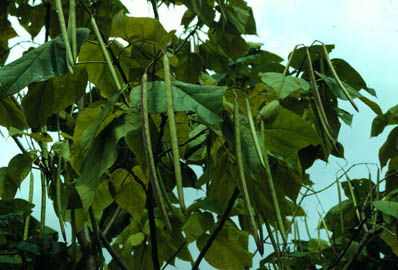
Catalpa

University of Georgia Herbarium
By Emily Graves
Family: Bignoniacaea (Trumpet-creeper family)
The New Royal Horticultural Society describes the Catalpa genus as "Leaves large, opposite or in whorls of 3, entire or shallowly 3-lobed, with red glandular spots beneath. Inflorescence a terminal panicle or raceme; calyx 2-lobed or irregular; corolla tube campanulate funnelform, 2-lipped, upper lip divided once, lower lip 3-lobed, limb margin crispate-undulate; stamens 2, curved; pistil 2-lobed. Capsule cylindrical, falcate, pendulous, persistent, 2-valved; seeds abundant, flat (Huxley, Anthony, Mark Griffiths, and Margot Levy, eds. The New Royal Horticultural Society Dictionary of Gardening. 4 vols. New York: The Stockton Press, 1992.
Species List
List obtained from: Huxley, Anthony, Mark Griffiths, and Margot Levy, eds. The New Royal Horticultural Society Dictionary of Gardening. 4 vols. New York: The Stockton Press, 1992.
Identification Guide:
There are several key differences between C. bignonoides and C. speciosa. First of all, when the leaves of C. bignonoides are crushed, they give an unpleasant aroma, but the leaves of C. speciosa do not do this. Also, C. speciosa makes a pyrimidal shaped tree, and the C. bignonoides tree has a roundish top created by wide-spreading branches. The leaves of C. bignonoides have short-acuminate, with densely flowered inflorescences and flowers that are three to five cm across. Whereas, C. speciosa leaves are long-acuminate with few flowered inflorescences and flowers that are five to six cm across.
General Information:
The name Catalpa comes form the name given to the tree by Natives Americans, Catawba. The genus is native to Eastern Asia, eastern North America, and the West Indies. The trees grow rapidly, and they have short and crooked trunks. Their bark is thick and reddish-brown. It has longitudinal ridges. The nectaries on the leaves are active from June to September. They peak in June and early July. The trees flower first and then produce fruit. The fruit stays on the trees all winter. The pod ripens in autumn, opens in the spring, and then falls off the tree. The tree supports several other organisms such as the catawba worm that is used as fishing bait. The only other economic use for the trees are as rails or fences or for landscaping purposes.
References:
Everett, Thomas H. Living Trees of the World. New York: Doubleday and Company, Inc., 1986.
Hora, Bayard, ed. The Oxford Encyclopedia of Trees of the World. New York: Oxford University Press, 1981.
Huxley, Anthony, Mark Griffiths, and Margot Levy, eds. The New Royal Horticultural Society Dictionary of Gardening.
4vols. New York: The Stockton Press, 1992.
http://www.bbg.org/nymf/encyclopedia/big/cat.0000.htm#key
http://www.exnet.iastate.edu/Pages/tree/catalpa.html
http://www.streetside.com/plants/floridata/ref/c/catalpa.htm